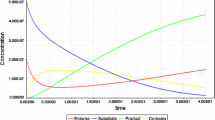Abstract
We present an application of stochastic Concurrent Constraint Programming (sCCP) for modeling biological systems. We provide a library of sCCP processes that can be used to describe straightforwardly biological networks. In the meanwhile, we show that sCCP proves to be a general and extensible framework, allowing to describe a wide class of dynamical behaviours and kinetic laws.
Similar content being viewed by others
References
Alur, R., Belta, C., Ivancic, F., Kumar, V., Mintz, M., Pappas, G., et al. (2001). Hybrid modeling and simulation of biomolecular networks. In Proceedings of fourth international workshop on hybrid systems: Computation and control, LNCS 2034 (pp. 19–32).
Blossey, R., Cardelli, L., & Phillips, A. (2006). A compositional approach to the stochastic dynamics of gene networks. Transaction Computer System Biology, 3939, 99–122.
Bortolussi, L. (2006). Stochastic concurrent constraint programming. In Proceedings of 4th international workshop on quantitative aspects of programming languages, QAPL 2006, ENTCS (Vol. 164, pp. 65–80).
Bortolussi, L. (2007). Constraint-based approaches to stochastic dynamics of biological systems. Ph.D. thesis, Ph.D. in Computer Science, University of Udine, http://www.dmi.units.it/~bortolu/files/reps/Bortolussi-PhDThesis.pdf.
Bortolussi, L., Fonda, S., & Policriti, A. (2007). Constraint-based simulation of biological systems described by molecular interaction maps. In Backofen, R., dal Palù, A., S. Will (Eds.), Proceeding of third international workshop on constraint-based methods in bioinformatics, WCB 2007 (pp. 1–9). Porto.
Bortolussi, L., & Policriti, A. (2006a). Modeling biological systems in concurrent constraint programming. In Dovier, A., dal Palù, A., Will, S., (Eds.), Proceedings of second international workshop on constraint-based methods in bioinformatics, WCB 2006 (pp. 6–29). Nantes.
Bortolussi, L., & Policriti, A. (2006b). Relating stochastic process algebras and differential equations for biological modeling. In Proceedings of PASTA 2006. Imperial College Press.
Bower, J. M., & Bolouri, H. (Eds.) (2000). Computational modeling of genetic and biochemical networks. MIT Press.
Calzone, L., Fages, F., & Soliman, S. (2006). Biocham: an environment for modeling biological systems and formalizing experimental knowledge. Bioinformatics, 22, 1805–1807.
Cardelli, L. (2005). Abstract machines of systems biology. Transactions on Computational Systems Biology, III, LNBI, 3737, 145–168.
Cardelli, L., & Phillips, A. (2004). A correct abstract machine for the stochastic pi-calculus. In Proceeding of Bioconcur 2004.
Cornish-Bowden, A. (2004). Fundamentals of chemical kinetics, 3rd edn. Portland Press.
de Boer, F. S., Di Pierro, A., & Palamidessi, C. (1995). Nondeterminism and infinite computations in constraint programming. Theoretical Computer Science, 151(1).
De Jong, H. (2002). Modeling and simulation of genetic regulatory systems: A literature review. Journal of Computational Biology, 9(1), 67–103.
Edelstein-Keshet, L. (2005). Mathematical models in biology. SIAM.
Elowitz, M. B., & Leibler, S. (2000). A synthetic oscillatory network of transcriptional regulators. Nature, 403, 335–338.
Swedish Institute for Computer Science (2007). Sicstus prolog home page. Swedish Institute for Computer Science
Gillespie, D. (2000). The chemical langevin equation. Journal of Chemical Physics, 113(1), 297–306
Gillespie, D., & Petzold, L. (2006). System modelling in cellular biology. Chapter Numerical Simulation for Biochemical Kinetics. MIT Press.
Gillespie, D. T. (1992). A rigorous derivation of the chemical master equation. Physica A, 22, 403–432.
Gillespie, D. T. (1976). A general method for numerically simulating the stochastic time evolution of coupled chemical reactions. Journal of Computers in Physics, 22, 403–434
Gillespie, D. T. (1977). Exact stochastic simulation of coupled chemical reactions. Journal of Physical Chemistry, 81(25), 2340–2361
Gutiérrez, J., Perez, J. A., Rueda, C., & Valencia, F. D. (2006). Timed concurrent constraint programming for analyzing biological systems. In Proceedings of MeCBIC’06.
Henkin, L., Monk, J. D., & Tarski, A. (1971). Cylindric algebras, Part I. North-Holland.
Hillston, J. (2005). Fluid flow approximation of pepa models. In Proceedings of the second international conference on the quantitative evaluation of systems (QEST05).
Huang, C. F., & Ferrell, J. T. (1996). Ultrasensitivity in the mitogen-activated protein kinase cascade. PNAS, Biochemistry, 151, 10078–10083.
Kitano, H. (2001). Foundations of systems biology. MIT Press.
Kohn, K. W. (1999). Molecular interaction map of the mammalian cell cycle control and dna repair systems. Molecular Biology of the Cell, 10, 2703–2734.
Norris, J. R. (1997). Markov Chains. Cambridge University Press.
Priami, C. (1995). Stochastic π-calculus. Computer Journal, 38(6), 578–589.
Priami, C., & Quaglia, P. (2004). Modelling the dynamics of biosystems. Briefings in Bioinformatics, 5(3), 259–269.
Priami, C., Regev, A., Shapiro, E. Y., & Silverman, W. (2001). Application of a stochastic name-passing calculus to representation and simulation of molecular processes. Information Processing Letters, 80(1), 25–31.
Rao, C. V., & Arkin, A. P. (2003). Stochastic chemical kinetics and the quasi-steady state assumption: Application to the gillespie algorithm. Journal Chemical Physics, 118(11), 4999–5010.
Regev, A., & Shapiro, E. (2002). Cellular abstractions: Cells as computation. Nature, 419, 343.
Saraswat, V. A. (1993). Concurrent constraint programming. MIT press.
Saraswat, V. A., Rinard, M., & Panangaden, P. (1991). Semantics foundations of concurrent constraint programming. In Proceedings of POPL.
Shapiro, B. E., Levchenko, A., Meyerowitz, E. M., Wold B. J., & Mjolsness, E. D. (2003). Cellerator: Extending a computer algebra system to include biochemical arrows for signal transduction simulations. Bioinformatics, 19(5), 677–678.
Vilar, J. M. G., Yuan Kueh, H., Barkai, N., & Leibler, S. (2002). Mechanisms of noise resistance in genetic oscillators. Proceedings of the National Academy of Sciences of the United States of America, 99(9), 5991.
Voit, E. O. (2000). Computational analysis of biochemical systems. Cambridge University Press.
Wilkinson, D. J. (2006). Stochastic modelling for systems biology. Chapman & Hall.
Author information
Authors and Affiliations
Corresponding author
Rights and permissions
About this article
Cite this article
Bortolussi, L., Policriti, A. Modeling Biological Systems in Stochastic Concurrent Constraint Programming. Constraints 13, 66–90 (2008). https://doi.org/10.1007/s10601-007-9034-8
Published:
Issue Date:
DOI: https://doi.org/10.1007/s10601-007-9034-8




